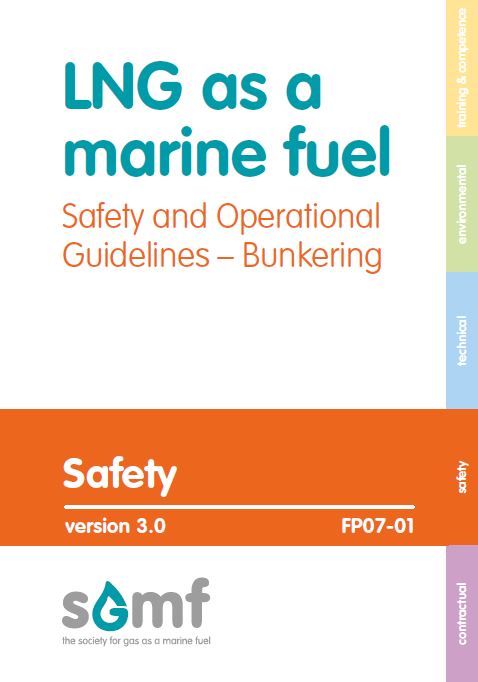
The Society for Gas as a Marine Fuel (SGMF) has released its 'LNG as a marine fuel - Safety and Operational Guidelines - Bunkering' publication. This third revision is the most comprehensive coverage of all aspects related to the bunkering of LNG fuel is more detailed than anything previously available.
The maritime industry is increasingly adopting liquefied natural gas (LNG) as the fuel of choice for newbuild vessels. Together with the environmental performance LNG use provides, this growing trend is also the result of the considerable expansion of the LNG bunkering supply infrastructure. Facilities are now well established in most parts of the world, and there are more operational LNG bunkering vessels serving the industry than ever before.
In anticipation of this growth and beyond, the safe use of LNG as a marine fuel has been a priority issue for SGMF. First published in 2014, the SGMF’s ’LNG as a marine fuel - Safety and Operational Guidelines - Bunkering’ publication has been significantly updated and revised for 2022 and these guidelines are a must have for anyone engaged with any aspect of LNG bunkering. The safety track record of LNG bunkering operations has been exceptional and SGMF has played a leading role in developing a ‘safety first’ approach to bunkering operations through its publications, work, and influence.
Today amongst the SGMF membership organisations there are tens of LNG bunkering ships operating with hundreds of ships using LNG between them, with LNG bunkering occurrences now in their thousands.
These latest guidelines take a holistic approach, incorporating the most recent operational experience into what is now an industry-leading publication. Starting from the design of bunkering vessels and facilities to the planning and preparation of the bunkering operations and locations, which is completed with guidance on safe fuelling operations. This comprehensive publication covers not only actual operations, but also the actions and activities leading up to that final stage, making the bunkering efficient and safe.

Samir Bailouni, Chairman, SGMF & Chief Operating Officer, Nakilat
Chairman of SGMF and Chief Operating Officer of Nakilat Samir Bailouni said: “The information contained in this publication is gold dust for anyone bunkering an LNG fuelled ship. These practices and insights are collated from the best the industry has to offer, and I extend my thanks to our members for providing this invaluable information not only for the benefit of the industry, but for society as a whole.”

Mark Bell, General Manager, SGMF
“The safe and sustainable use of gaseous marine fuels are the core objectives for SGMF and these bunkering guidelines for LNG are a cornerstone reference for the industry. As the industry grows, being able to supply new entrants with these guidelines provides them with a valuable head start in ensuring they can operate with maximum safety and efficiency, no maritime gas fuelled project should be without them. The industry now has a comprehensive portfolio of publications for LNG as a marine fuel and the Society will continue to update them with good, if not the best, practice the industry has to offer. Whilst the industry currently debates other future gaseous marine fuels such as ammonia and hydrogen, be assured SGMF is currently working on and will produce further guidelines for these fuels in a similar manner to what it has done for LNG. Meanwhile, I strongly encourage and advocate the continued focus on safe and sustainable bunkering for all these fuels through support for the important work and leadership of the Society in these aspects.” said Mark Bell, General Manager of SGMF.
The ‘LNG as a marine fuel - Safety and Operational Guidelines – Bunkering’ publication provides a wealth of information relevant to all stakeholders, from ship owners and operators, suppliers of LNG as a marine fuel, maritime administrations, port authorities and terminal operators, and local and national authorities.
“Bunkering LNG involves a range of potential hazards, but when good practice is applied and followed, the risks can be effectively mitigated. The overall aim of this new publication is to ensure that gas-fuelled ships can be bunkered safely, reliably, efficiently, and in an environmentally responsible way. It has only been made possible through the partnership, cooperation, support and open information from of our members” Mark Bell points out.
The publication addresses the specific requirements for LNG used as a marine fuel, as well as synthetic and bio-LNG. Its content may also, with appropriate limitations, be used as a reference for other low-flashpoint fuels and systems not specifically addressed in these guidelines.
The publication is available for members to download via the SGMF
website. Non-members can pre-order it from the web shop
here, for anticipated delivery by the end of February.
The opinions expressed herein are the author's and not necessarily those of The Xinde Marine News.
Please Contact Us at:
media@xindemarine.com




 Ningbo Containerized Freight Index Weekly Commentar
Ningbo Containerized Freight Index Weekly Commentar  Ningbo Containerized Freight Index Weekly Commentar
Ningbo Containerized Freight Index Weekly Commentar  Ningbo Containerized Freight Index Weekly Commentar
Ningbo Containerized Freight Index Weekly Commentar  BIMCO Shipping Number of the Week: Bulker newbuildi
BIMCO Shipping Number of the Week: Bulker newbuildi  Ningbo Containerized Freight Index Weekly Commentar
Ningbo Containerized Freight Index Weekly Commentar  Ningbo Containerized Freight Index Weekly Commentar
Ningbo Containerized Freight Index Weekly Commentar